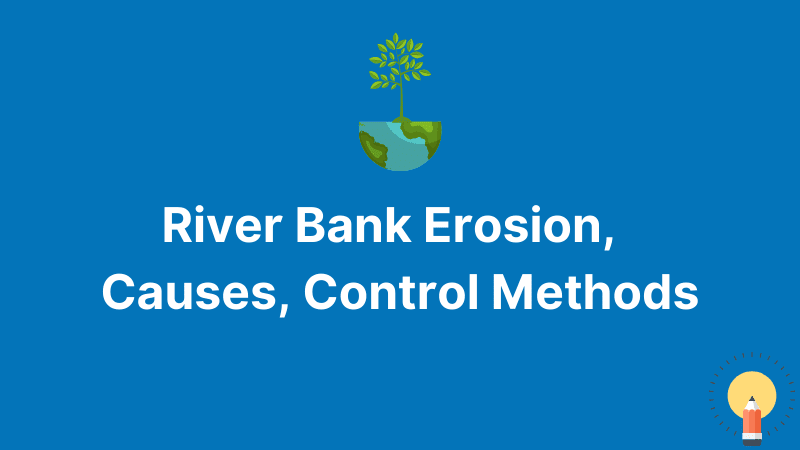River Bank Erosion | Causes | Control Methods
Rivers are ever-changing structures. They modify their flow patterns on a regular and natural basis. Because the river bank absorbs the energy, these changes have an impact on soil stability. River bank erosion is one example of how nature is changing. River bank erosion occurs when the banks of a river erode owing to watercourse erosion.
River bank erosion is of two types:
Bank scour: It refers to the removal of bank materials by moving water and sediment.
Mass failure: A mass collapse happens when pieces of the banks fall and tumble into the river stream.
Causes of River Bank Erosion
Although river bank erosion is a natural phenomenon, human activity may hasten it. The natural causes of river bank erosion are as follows:
Flood
Floods are the most important cause of river bank erosion. Flooding is more likely during the wet season. During a flood, the massive volume of water moving at high speeds generates enough energy to rip away the top layers of soil or potentially induce widespread collapse. Centrifugal force raises the water height, resulting in the greatest depth of flow at the outer bend, while gravity force pushes the water down. The erosive force is the downhill velocity against the bank.
You Should Also Read:
- 20 Good Foods That Your Cats Will Love
- 5 Best Flowering Trees For California By Color
- Delicious Fruits That Are The Best for Dogs
Heavy rainfall
Heavy and severe rainfall will degrade soil. Strong waves are often created by heavy rains, which can loosen and wear away non-cohesive bed materials.
Sedimentation
Sedimentation can be caused by a variety of natural disturbances. As the banks of a river get saturated, silt collection diminishes the river's ability to retain water. As a result, the river's course has shifted. As a result of eroding river banks, meandering rivers arise.
Strong Current of Rivers
Because of the amount of water moving or the high stream gradient, strong currents form. River bank erosion may occur if river currents are quite strong. In the case of cohesionless bed materials, these powerful currents erode away non-cohesive materials, resulting in a cantilever overhang of cohesive materials. As a result, shear stress surpasses the critical shear near the bank's toe, and erosion begins.
Man-made Causes of River Bank Erosion
Deforestation causes River Bank Erosion
Humans assist to erosion by cutting down trees on the bank for personal use, so reducing the natural reinforcing that occurs there.
Housing near bank
People in rural regions build their dwellings along the bank, which increases the compressive strain of the soil beyond its limit, causing erosion.
Soil extraction & River Bank Erosion
Humans take vast amounts of soil from the bank for their personal use, or they take massive amounts of sand and gravel, which assist to keep the soil back. They are hastening river bank erosion by doing so.
Impacts of river bank erosion
River bank erosion has several social and economic consequences. It causes individuals to become homeless when they lose their property and are forced to relocate. It may sometimes result in death. Humans become impoverished, and important land is destroyed as a result of erosion. Bangladesh has the greatest rate of river bank erosion in the world.
According to the statistics, Bangladesh has lost about 660 square kilometers of land owing to Padma river bank erosion since 1966. According to a research on Brahmaputra river erosion in Mymensingh district, the erosion rate was 1050 hectares on the left bank and 850 hectares on the right bank between 2006 and 2010. Furthermore, Assam, an Indian state, has lost about 7.4 percent of its land area owing to river bank erosion caused by the Brahmaputra and its tributaries.
River bank erosion control methods
There are various methods for controlling river bank erosion and protecting the bank area.
Soil erosion mats or blankets
Soil erosion mats or blankets are stabilizing materials that strengthen the soil and stabilize the bank until plants may take root. They aid in slowing the flow velocity of water over the surface.
The major goal is to keep the dirt in place and prevent it from moving away. They protect and cover the soil while also maintaining perfect growth conditions. As a result, they prevent gullies from forming. They may be utilized on a level surface as well as a steep incline.
It consists mostly of a grid, lattice, or open mesh screen supported by random filament looping patterns. As a basis for soil retention, backing elements are sometimes added below and parallel to the lattice. Slope anchoring secures wire mesh and net backing to the surface. The anchor offers holding capability as well as resistance to pull-out. The anchor is comprised of a 30" length of 12" diameter ductile iron or aluminum rod.
Polypropylene is used to make the net backing. The filaments are then interlocked and laid over the lattice's cross bars. As a result, it develops a reinforcing structure. It does, however, offer water drainage, which aids in the growth of plants. It is permeable enough to support plant growth.
Because it is a nonwoven sheet, it is weighted with sand, gravel, and slag to keep the structure in place and prevent it from washing away. It has a homogeneous thickness and fibers that are evenly dispersed. German Patent Specification No. 2,321,362 describes one example of this style of matting. It's a tangled nonwoven matting made up of helically crimped synthetic microfibers that are joined at the intersections.
Soil erosion mats come in a variety of styles. The kind of mat or blanket to employ is determined by the soil quality, slope of the bed, flow velocity, and time necessary to produce plants. With the application of seeds and nutrients, a vegetative cover is placed. We may need to excavate or fill the bed slope at times. The slope ratio may range from 1.5:1 to 3:1. The mats or blankets should be positioned vertically downslope.
Biodegradable erosion control mats
Coir coconut fibers, aspen fibers, jute, wood fibers, or straw are examples of natural materials that biodegrade over time. Depending on the content of the matting, it might take months to years for the fibers to degrade in the environment.
It is better to utilize coir fiber. Coir fibers are robust natural fibers that can withstand being submerged in water for two to five years. It may provide temporary reinforcement by stabilizing the soil.
Photo Degradable Erosion Control Mats
The netting of this mat is constructed of plastic-like materials that include UV stabilizers. They cease to operate after their shelf life has expired. The netting then deteriorates as a result of the exposure to sunlight.






